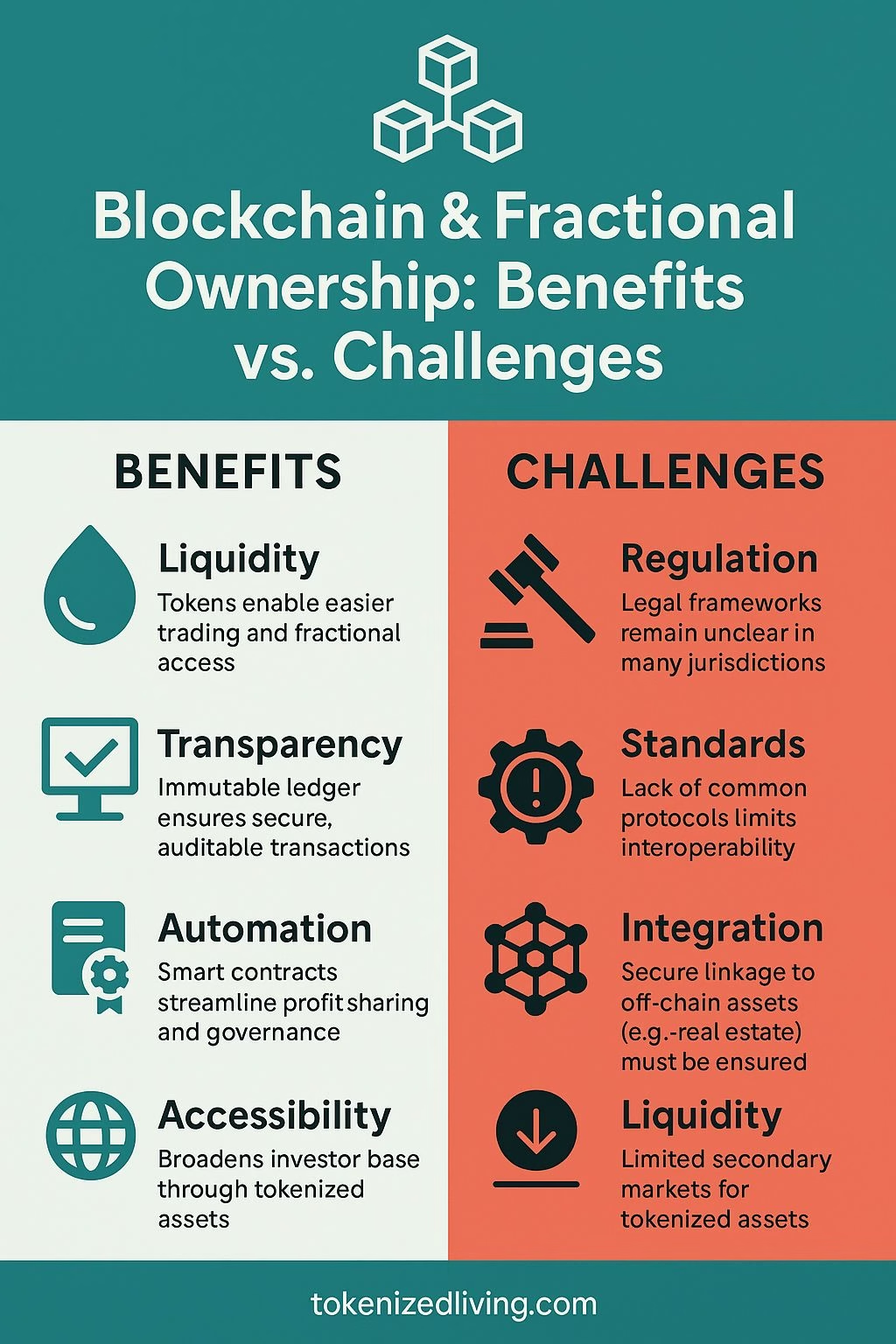Blockchain transforms fractional ownership by turning high-value assets like real estate and art into liquid, tradable tokens. It ensures trust via immutable ledgers, automates profit-sharing through smart contracts, and lowers entry barriers—broadening access and driving liquidity in previously exclusive markets.
“Blockchain technology is not just a buzzword—it’s the engine driving the latest innovations in fractional ownership.”
— Tokenized Living, from “The Role of Blockchain in Fractional Ownership”
Fractional ownership is rapidly gaining traction as a transformative way to invest in high-value assets. The emergence of blockchain technology has taken this concept to the next level, providing unparalleled security and transparency. Whether it’s real estate, art, or intellectual property, the influence of blockchain in fractional ownership reshapes how we approach it.
Blockchain: The Backbone of Modern Fractional Ownership
Blockchain technology is not just a buzzword—it’s the engine driving the latest innovations in fractional ownership. Here’s a closer look at how it’s making this investment model more secure and transparent.
Tokenization: Making Assets Accessible
By now, many investors are familiar with the idea of tokenization. In essence, it’s about turning a physical or digital asset into smaller, tradeable units on a blockchain. These tokens represent a share of the asset, making it easier for people to invest without needing large sums of money. With blockchain, tokenization isn’t just a theoretical concept; it’s a practical way to democratize access to valuable assets.
Smart Contracts: Automating Trust
One of the standout features of blockchain is the smart contract. These self-executing contracts automate and enforce the terms of an agreement, such as the distribution of profits or the transfer of ownership. This reduces the need for intermediaries and ensures that everything runs smoothly and securely.
Security and Immutability: Protecting Your Investment
Security is always a concern with investments; this is where blockchain truly shines. The data on a blockchain is immutable, meaning it cannot be changed or tampered with. This provides a secure environment for fractional ownership, ensuring that all transactions are transparent and verifiable.
Where Blockchain is Making an Impact
Blockchain’s potential isn’t just theoretical; it’s already being applied in various industries, changing the way we think about ownership.

Real Estate: Opening New Doors
Real estate has traditionally been a difficult market to enter, especially for small investors. Blockchain changes this by enabling fractional ownership through tokenization. Platforms like RealT are leading the way, allowing investors to buy shares of properties and benefit from rental income and appreciation.
Art and Collectibles: Broadening Access
The art world is another area where blockchain is making a significant impact. By tokenizing high-value artworks, platforms like Maecenas are making it possible for more people to invest in pieces that were previously out of reach. This not only democratizes access to art but also adds a new layer of liquidity to the market.
Intellectual Property: Monetizing Creativity
Intellectual property (IP) has always been a valuable asset, but it’s often difficult to monetize. Blockchain allows for the tokenization of IP rights, making it easier for creators to sell shares of their work. This provides immediate liquidity and offers investors a way to profit from the success of patents, trademarks, and other IP assets.
Beyond the Usual Advantages
While liquidity and accessibility are often highlighted as key benefits of blockchain in fractional ownership, let’s explore a few less commonly discussed but equally important aspects.
Real-Time Transparency
Unlike traditional models, where updates are slow and often opaque, blockchain offers real-time visibility into transactions and ownership changes. This not only builds trust but also keeps investors engaged, knowing they can track their investments at any moment.
Global Reach
Blockchain knows no borders, enabling investors from around the world to participate in fractional ownership. This global accessibility not only broadens the pool of potential investors but also increases the liquidity of tokenized assets.
Integration and Interoperability
As blockchain platforms become more interoperable, tokens issued on one platform can be traded or used on another. This integration between platforms enhances liquidity and provides more opportunities for investors to diversify their portfolios.
Regulatory Uncertainty
The regulatory landscape for blockchain and tokenized assets is still developing. Different jurisdictions have different rules, which can create uncertainty for platforms and investors alike.
Adoption Barriers
Blockchain technology, while promising, is still relatively new. Many potential investors may not fully understand how it works, which could be a barrier to widespread adoption.
Security Concerns
Although blockchain is inherently secure, it’s not without risks. Vulnerabilities in smart contracts or issues with private key management can lead to significant losses. It’s crucial for platforms to continually improve their security measures and for investors to stay informed.
Conclusion: The Future of Fractional Ownership
Blockchain is undeniably reshaping fractional ownership, making it more secure, transparent, and accessible. As this technology continues to evolve, we can expect to see even more innovative applications and broader adoption across various asset classes.
For investors, creators, and anyone interested in the future of finance, the role of blockchain in fractional ownership is a topic worth watching closely. By staying informed and choosing the right platforms, you can take full advantage of the opportunities that this technology offers.
❓ FAQ – The Role of Blockchain in Fractional Ownership
Blockchain turns an asset into tradable tokens on a ledger. It improves liquidity, offers transparency, and enables global, peer-to-peer ownership.
Smart contracts automatically handle profit distribution, transfers, and compliance rules. That reduces intermediaries and errors, enhances trust—and speeds everything up.
Yes. Blockchain offers immutable transaction records—no tampering and full audit trails. Combined with trusted tokenization standards, it’s built for security.
Real estate, fine art, collectibles, luxury goods—and increasingly structured IP or data tokens. Tokenization democratizes access across sectors.
Regulatory uncertainty, lack of global standards, integration challenges (e.g. secure oracles), and limited secondary market liquidity are still barriers.
Platforms like Securitize support real-world asset token issuance—from real estate to private equity—backed by public and private blockchains.
We use AI tools to enhance research and drafting, always under human supervision.

